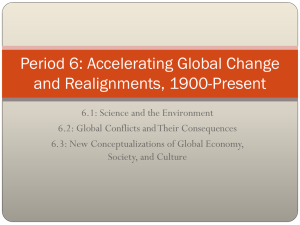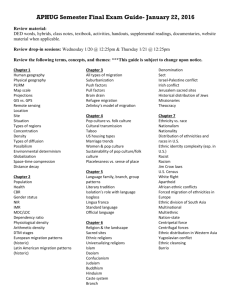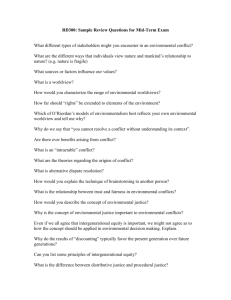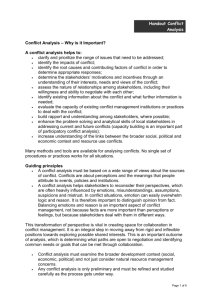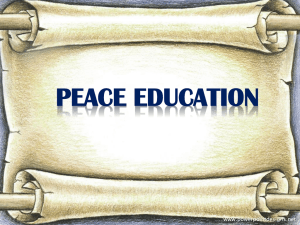Social and political contexts of conflict William A V Clark
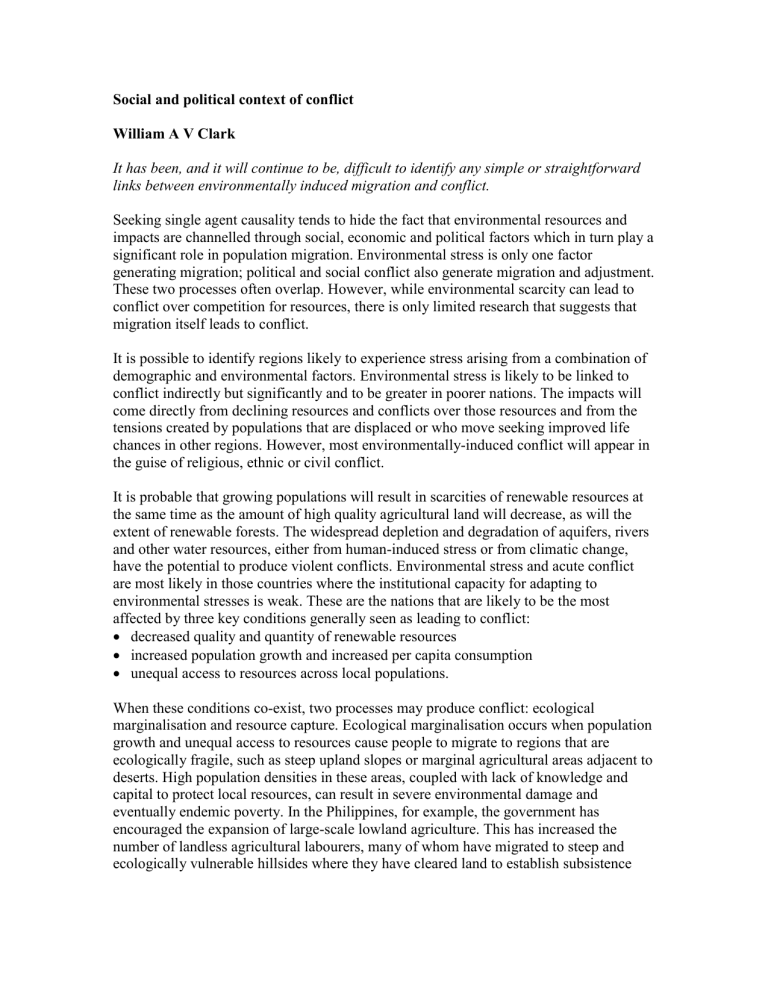
Social and political context of conflict
William A V Clark
It has been, and it will continue to be, difficult to identify any simple or straightforward links between environmentally induced migration and conflict.
Seeking single agent causality tends to hide the fact that environmental resources and impacts are channelled through social, economic and political factors which in turn play a significant role in population migration. Environmental stress is only one factor generating migration; political and social conflict also generate migration and adjustment.
These two processes often overlap. However, while environmental scarcity can lead to conflict over competition for resources, there is only limited research that suggests that migration itself leads to conflict.
It is possible to identify regions likely to experience stress arising from a combination of demographic and environmental factors. Environmental stress is likely to be linked to conflict indirectly but significantly and to be greater in poorer nations. The impacts will come directly from declining resources and conflicts over those resources and from the tensions created by populations that are displaced or who move seeking improved life chances in other regions. However, most environmentally-induced conflict will appear in the guise of religious, ethnic or civil conflict.
It is probable that growing populations will result in scarcities of renewable resources at the same time as the amount of high quality agricultural land will decrease, as will the extent of renewable forests. The widespread depletion and degradation of aquifers, rivers and other water resources, either from human-induced stress or from climatic change, have the potential to produce violent conflicts. Environmental stress and acute conflict are most likely in those countries where the institutional capacity for adapting to environmental stresses is weak. These are the nations that are likely to be the most affected by three key conditions generally seen as leading to conflict:
decreased quality and quantity of renewable resources
increased population growth and increased per capita consumption
unequal access to resources across local populations.
When these conditions co-exist, two processes may produce conflict: ecological marginalisation and resource capture. Ecological marginalisation occurs when population growth and unequal access to resources cause people to migrate to regions that are ecologically fragile, such as steep upland slopes or marginal agricultural areas adjacent to deserts. High population densities in these areas, coupled with lack of knowledge and capital to protect local resources, can result in severe environmental damage and eventually endemic poverty. In the Philippines, for example, the government has encouraged the expansion of large-scale lowland agriculture. This has increased the number of landless agricultural labourers, many of whom have migrated to steep and ecologically vulnerable hillsides where they have cleared land to establish subsistence
agriculture. Civil dissent has increased in these areas which are largely beyond the effective control of the central government.
Resource capture describes the situation in which there is competition between powerful and less powerful groups for the declining quantity or quality of renewable resources. In
Senegal and Mauritania, West Africa, dams were built along the Senegal River in order to regulate river flow, produce hydropower, enable expansion of irrigated agriculture and provide river transport to the ocean. While these may be laudable goals, the outcomes led to increased land values along the river and a struggle between power élites for the control of these lands. The more powerful élites then changed property rights and resource distribution in their own favour, which produced a sudden increase in resource scarcity for the ethnic minority and the expulsion of 20,000 marginalised Mauritanians to
Senegal – from where they then launched raids to retrieve expropriated cattle.
Even though these two cases illustrate the potential for conflict resulting from environmental change or environmental stress, the conflicts themselves are embedded in social and political contexts. Environmental changes form the background to tensions in which some other event is a trigger for conflict. Poor countries will in general be more vulnerable to damaging environmental change than rich ones, and poor migrants are more likely to be affected than rich migrants. The social and political context is immensely broad and complex and includes patterns of land distribution, family and community structure, and economic and legal incentives, including systems of property rights and markets. All of these interact with environmental change, and it is not simply environmental change that leads to conflict. Indeed, environmental conflicts may manifest themselves as political or social tensions, including ethnic and religious conflicts, rather than conflicts over resources per se.
All of the research on the broad issue of human security and the environment must be set within the context of three premises. First, we must recognise that human perceptions of environments, and the way we use environments, are socially, economically and politically constructed. Second, environmental problems must be addressed from a perspective that encompasses both poverty and inequality. Third, the nation state may not be the appropriate level at which to examine these questions.
Likelihood of conflict
Where environmentally induced migration and conflict might occur is slightly more easily answered than whether it will occur and to what extent . Demographic stress (and possible conflict) can be categorised on a scale from very high risk (where there is a large
‘youth bulge’, rapid urban growth and low cropland or freshwater availability), high risk
(large youth bulge and either rapid urban growth or low cropland/freshwater availability) low risk (low cropland or fresh water availability) to no risk (none of these factors). This process identifies Africa and, to a lesser extent, the Middle East as primary areas of potential conflict and tension arising from rapid population growth and environmental stress. There are other ‘hot spots’ in Asia and northern South America.
Conflicts arising from environmental change are much less likely than conflicts generated by religious, ethnic and other rivalries. That said, it is clear that environmental stress in the ‘high risk’ nations is likely to be a factor in increasing population dislocation and potential conflict.
Twenty-five countries – of which the majority are in Africa – have been identified as falling in the highest risk category of civil conflict in the next two decades, and the likelihood continues to increase over time. All these countries have low cropland availability per person, half of them have fresh water availability problems and all are ranked amongst the poorest nations in the world.
Conclusion
Environmental stress is likely to be linked to conflict indirectly but significantly. Its impacts will come directly from declining resources and conflicts over those resources and from the tensions created by populations that are displaced or who move seeking improved life chances in other regions. However, most of the conflicts will embed environmentally induced conflict under the guise of religious, ethnic or civil conflict. It has been and will continue to be difficult to identify any simple or straightforward links between the environment, environmentally induced migration and conflict.
William Clark ( wclark@geog.ucla.edu
) is a professor in the Department of Geography at the University of California, Los Angeles (www.ucla.edu).
This article is an edited version of a longer article of the same title prepared for the
German Advisory Council on Global Change (WBGU), published in 'Climate Change as a
Security Risk', Earthscan 2008, London and Sterling VA

